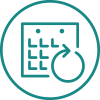
HIL Serum Indices

HIL Serum Indices
Purpose:
The clinical usefulness of laboratory test results depends on performance evaluation and detection of errors including those that affect the integrity of the sample and presence of interferants in that sample. Most manufacturers now include Haemolytic / Icteric / Lipaemic (HIL) Indices as part of their testing repertoire as a means of identifying these interfering parameters.
The three major sample interferences found to affect the accuracy and reliability of most laboratory results are haemoglobin, lipaemia and Icterus. Each of these interfering substances is a potential source of biological and analytical bias, which ultimately compromises the reliability of measurements of different parameters in routine clinical chemistry testing:
Lipaemia is turbidity of the sample caused by accumulation of lipoprotein particles, with chylomicrons contributing the greatest turbidity effect. It can be detected visually if the concentration of triglycerides in patient samples is > 3.4 mmol/L (300 mg/dl) and is often secondary to other disease states such as: diabetes mellitus, ethanol use, chronic renal failure and pancreatitis. In hospitalised patients it can also be caused by sampling too soon after administration of parenteral lipid emulsions such as Intralipid.
Icterus is the term given to elevated concentrations of bilirubin. Such elevations can be found in a variety of conditions including acute and chronic liver disease, biliary cirrhosis, alcoholism or as a physiological response to many drugs. The visual recognition of hyperbilirubinaemia is often not sufficiently sensitive. Because of the high absorbance of bilirubin within the range 340 to 500 nm and the high background, the linearity range of methods can become a limiting factor for spectrophotometric analyses at these wavelengths.
The aim of the Weqas HIL Serum Indices programme is to assess: the ability of the analysers HIL indices test to identify the presence of these potential interference, to determine how laboratories deal with results where indices suggest that interferences are present and to promote the harmonisation of reporting.
Scope:
The programme provides 3 monthly samples containing either no interferant, bilirubin, haemoglobin, intralipid (surrogate marker of turbidity) or a mix of interferants at a range of concentrations. A batch is prepared every 6 months consisting of 14 serum pools: 3 haemolysed, 3 icteric, 3 intralipid, 4 mixed and 1 negative. A total of 18 samples are dispatched every 6 months, with some pools dispatched on more than one occasion. The target value is assigned from the calculated gravimetric addition of the interferant, supported by the quantitative analysis of bilirubin, haemoglobin and triglyceride (as an approximate verification of the concentration of intralipid). Both semi-quantitative and qualitative results are accommodated.
 |
Key Features:
|
| Serum Indices Programme | |
|---|---|
| Analyte | Approx. Range Covered |
| Semi-Quantitative Haemolysis Index | 0 - 3.5 g/L as Hb |
| Semi-Quantitative Icterus Index | 0 - 500 μmol/L as Total Bilirubin |
| Semi-Quantitative Lipaemic Index | 0 - 10 mmol/L as Intralipid Triglyceride |
| Qualitative Haemolysis Index | Negative to +++ Positive |
| Qualitative Icterus Index | Negative to +++ Positive |
| Qualitative Lipaemic Index | Negative to +++ Positive |








